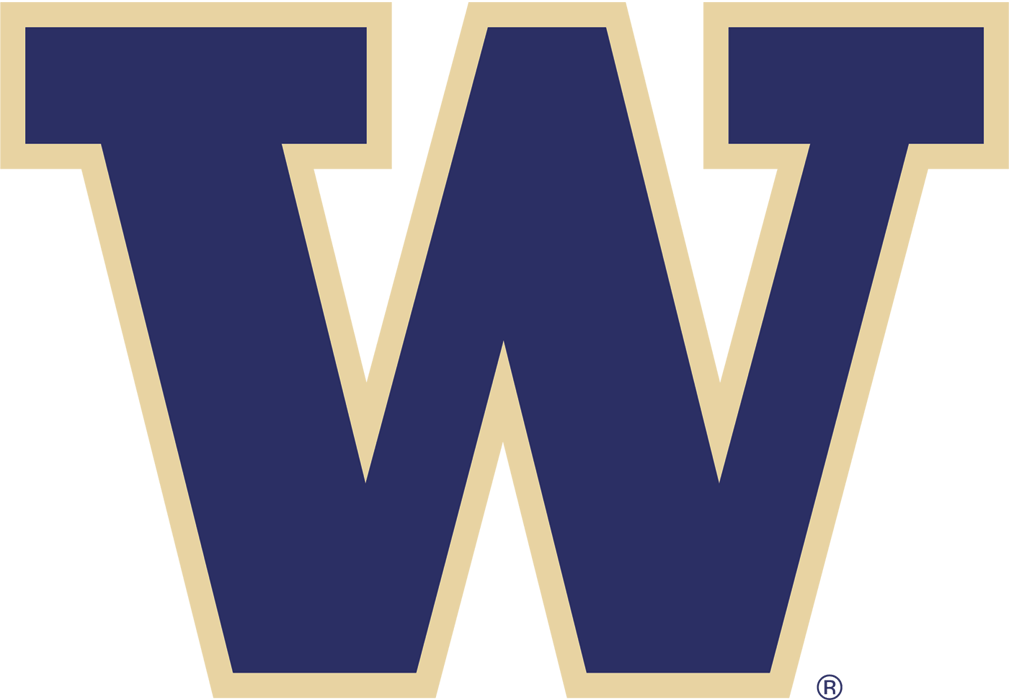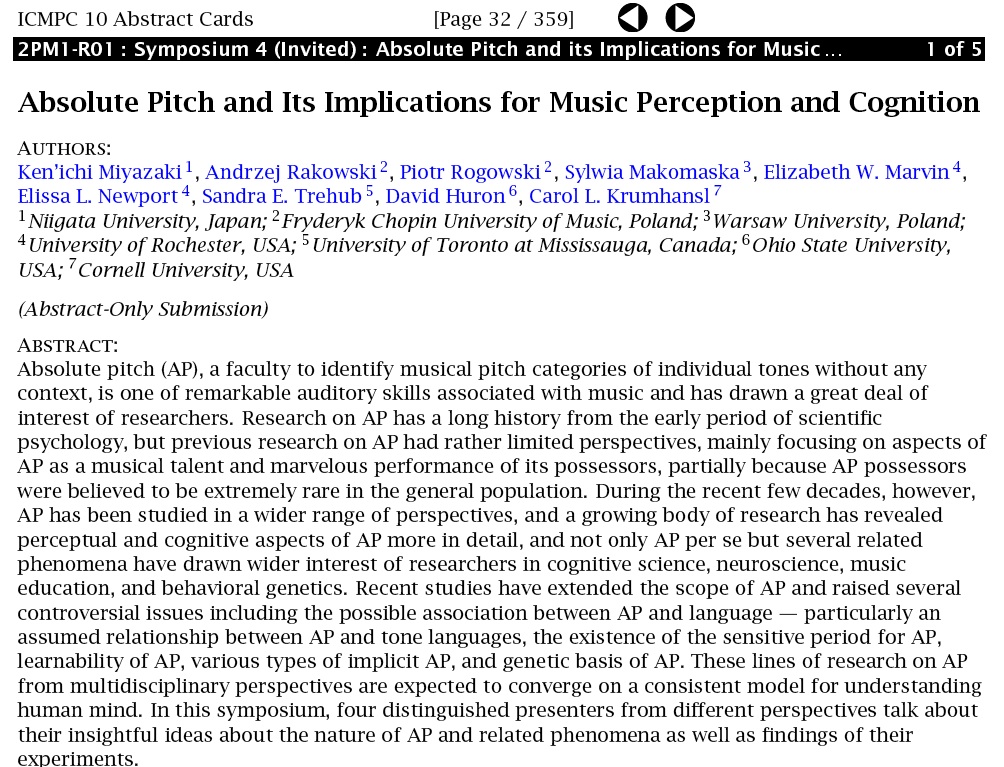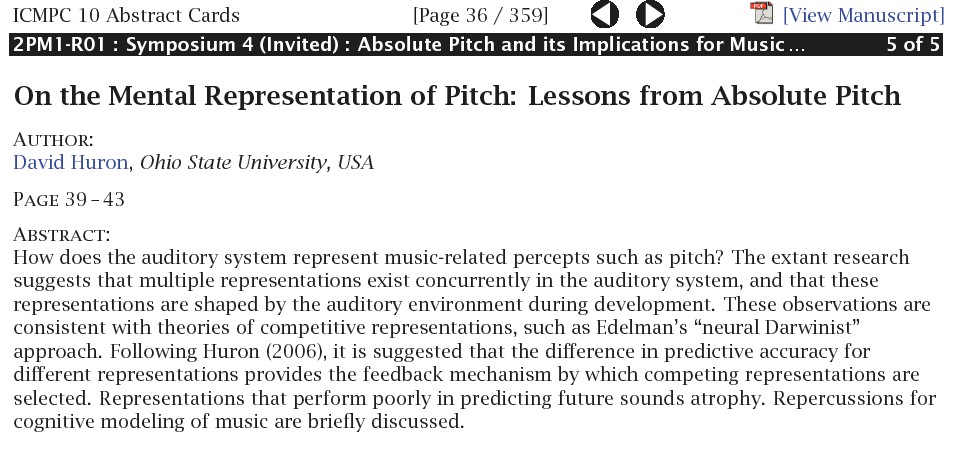 11th
INTERNATIONAL CONFERENCE ON
11th
INTERNATIONAL CONFERENCE ON
MUSIC PERCEPTION AND COGNITION
August 23-27, 2010
Seattle, Washington USA

Registration and
Accommodation
Campus Area Map
(Downnloads in pdf format)
Program
Updated!
Instructions for Presenters
Sightseeing in Seattle
Updated!
Keynotes
Sponsors
Getting to Seattle
Updated!
Campus Area Map
The University of Washington
The UW School of Music
Submissions
CLOSED December 15
Questions?
Email: ICMPC11

Instructions
for Presenters - Click
Here
This file includes important
information on available equipment and how to prepare the spoken papers
and posters for presentation. NOTE: All spoken presentations requiring
poewrpoint, sound or video, must be in a format that can be downloaded
to the conference laptops in each room and played via computer.
PROCEEDINGS
INSTRUCTIONS
Templates
Short Abstract
Template - Abstract Book
Structured
(longer)
Abstract
Template - Proceedings
Full Paper Template -
Proceedings
Just a note to try to resolve some of the (justifiable) confusion around submitting documents for the proceedings. Please read the entire message. Thank you.
1. REFERENCES - No references in the short abstract. For the structured abstract or full paper authors should use current APA style. The template examples were WRONG and have been changed to reflect the correct style.
2. SHORT ABSTRACT - All presenters should submit to Causal Productions a short abstract of their presentation for the abstract book. I posted a separate template above for this abstract. Below is an example of how this appeared in the proceedings from ICMPC10. Note that it says (Abstract-only Submission). Authors may choose to submit ONLY the short abstract of their presentation for the proceedings. (please scroll down)

3. SUBMITTING FULL PAPERS For authors that wish to have a more significant portion of their work represented in the proceedings, they may submit an additional short form of their paper (structured abstract of 1-2 pages)
OR a full paper version of their presentation or poster which INCLUDES a space for the short abstract in keeping with normal publishing standards. You may just paste the same abstract you already submitted into that template and continue with the full paper. ANY presenter (paper or poster) may submit a full paper version of their work. That kind of submission appears like THIS in the proceedings. Note the Manuscript icon in the upper right corner to download the full paper.

I hope this clarifies the procedure and I apologize for the confusion.
The following guidelines apply to ALL papers accepted for the conference.
1. Registration
Your place in the program will not be confirmed unless your registration fee has been received by April 30th 2010. Full details of how to register and submit payment are on the web site at http://depts.washington.edu/icmpc11/registration.html. Please also note that we cannot guarantee the return of fees, in whole or in part, once paid.
2. Short Abstract Submission - All authors must submit a 250-word abstract of their presentation.
A short abstract forms part of your manuscript (whether structured abstract or full paper) for inclusion in the conference program. The abstract is the first section of your manuscript. Please refer to the appropriate sample template which includes a space for the 250 word abstract. The abstract section in your manuscript should be limited to 250 words, with no tables, no graphics and no subheadings and no references. Beyond that you may choose whether to submit a full paper or a revised version of your structured abstract submission (see below).
3. Proceedings – All authors may submit either a full paper (long) or structured abstract (short) version of their research for the proceedings document.
The preferred submission method is via email attachment to: manuscripts@causalproductions.com with Subject: ICMPC11 manuscript #nnn (replace "nnn" with the ID number provided to you by the Conference Organizer e.g. #PA001).
LANGUAGE: English
PAPER SIZE: Full paper and structured abstract submissions should be formatted for US letter size 8.5" x 11" paper (approximately 21.6 cm x 27.9 cm).
FULL PAPER SUBMISSIONS
Full Paper Template
THE DEADLINE FOR SUBMISSION OF YOUR PAPER FOR THE PROCEEDINGS VOLUME IS MAY 1st 2010
All documents are to be sent directly to Causal Productions by email or FTP. All submissions will be acknowledged directly to the author within 1-2 days of receipt.
Causal Productions can accept several types of files from authors, however PDF or POSTCRIPT are preferred.
• PDF file or Postscript file are preferred
• WORD may reflow pages differently if a different printer driver is used or a different version of WORD is used; as a result, the PDF file generated by Causal Productions from your WORD file may have a page layout different from what you see on your own computer screen in WORD.
The preferred submission format is “full-paper” (4 page limit recommended) The recommended length for full-paper submissions is 4 pages, though submissions up to 8 pages will be included at no extra cost. Authors of longer submissions will be contacted by Causal Productions and will have the option of either editing the document prior to the final submission deadline or paying US $100 per page for each additional page
Graphics Authors who wish to use graphics in their manuscripts should consider the
following:
• graphics that take up more than one column width must be positioned at the top or at the bottom of the page.
• graphics may be full color; all color will be retained on the CD-ROM.
• graphics must not use stipple fill patterns because they will not reproduce properly in Acrobat PDF. Please use only SOLID FILL COLORS.
STRUCTURED ABSTRACT SUBMISSION
Structured Abstract Template
Authors have the option of submitting a structured abstract. THE DEADLINE FOR SUBMISSION OF YOUR STRUCTURED ABSTRACT FOR THE PROCEEDINGS VOLUME IS MAY1st 2010 each author should submit either a full paper or structured abstract, not both.
To ensure your preferred page layout is retained, please submit a PDF file or a Postscript file and make sure that ALL FONTS are embedded. Causal Productions accepts WORD files (.doc) from authors but only as a last resort.
A required abstract forms part of your manuscript (whether structured abstract or full paper). The abstract is the first section of your manuscript. Please refer to the sample templates. The abstract section in your manuscript should be limited to 250 words, with no tables, no graphics and no subheadings.
NOTE:
Your 250-word abstract as submitted will appear in the book of abstracts that will be given to all delegates on arrival at the conference.
The Proceedings of the Conference will be in the form of a CD-ROM readable by both Mac and PC. This will also be available at the conference, and will be free to all registered delegates.
In order for a written version of your full paper or structured abstract to be included in the proceedings, we need to receive this by 1ST MAY 2010.
4. POSTER GUIDELINES - Instructions for Poster Presentations
Poster presentations will appear in the ICMPC11 conference program, abstract book, and proceedings. Posters will be on display for the entire day of their presentation. Authors are expected to be present with their poster during the time slot allocated for the poster session that day.
Poster Size - Posters will be displayed in designated spaces within a dedicated room at the conference site. To fit on the display area, posters should measure no more than 36 inches wide by 48 inches long in portrait style (approximately 0.9 x 1.2 meters). Velcro adhesive tabs or pushpins will be supplied at the conference site (see Mounting and removing Materials below). The materials to be mounted should be brought ready-made on poster paper. Do not use heavy cardboard. Do not plan to write on the poster board itself.
Handouts - You might also like to bring handouts, such as copies of your four-page paper from the Proceedings to distribute to interested delegates as you present your research. Always include your contact information (especially email address) on handouts, so delegates will have a means for communicating with you about your research. There are a couple of conveniently located photocopying shops near the University, so you can make copies of handouts upon your arrival, if you do not want to carry the heavy papers with you as you travel. If you would like to contact one of these shops directly, email addresses are supplied below:
Kinko's - Seattle WA University District
810 NE 45th St
Always open
Phone: (206) 545-7218; Fax: (206) 545-4831
Email: usa5134@kinkos.com
RAMS COPY CENTER
4144 University Way NE
Seattle, Washington 98105
Phone: (206) 632-6630 FAX: (206) 632-6730
Email: Info@RamsCopy.com
Ave Copy Center
4141 University Way, NE, Suite 103
Phone: (206) 633-1837
Email: mail@avecopy.com
Mounting and Removing Materials - Velcro adhesive tabs and/or pushpins will be made available to primary authors of poster sessions at the on-site conference registration table. Authors are responsible for setting up and removal of posters.
Poster Board Formatting and Layout
Type sizes: The presentation title should be printed across the top of the poster in characters of at least 70 pt. Author(s) and affiliation(s) should be at least 36 pt. Subheadings should be at least 24 pt and all text, including figures and tables, should be no smaller than 16 pt.
Title 70 pt.
Authors & affiliations 36 pt.
Section Headings 24 pt.
Body Text 16 pt.
In no case, should the text be less than 16-point in size. Use a font that is easy to read from a distance such as Arial or Times Roman.
Illustrations - Keep in mind that the poster will be viewed from a distance and that a picture can effectively communicate what might take many words to explain. Carefully considered use of large format figures can capture important aspects of your research and save on the amount of text required and, as a result, the reading time required of interested delegates.
Use figures to illustrate your experimental design, theories, procedure, stimuli, and results. Each illustration should have a heading of one or two lines in large type clearly stating the significance. Detailed information should be provided in a legend in smaller type below. This information replaces the commentary that would ordinarily constitute the body of a manuscript, but in abbreviated form. It should clearly describe the content of the illustration and the conclusions to be drawn from it.